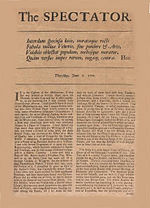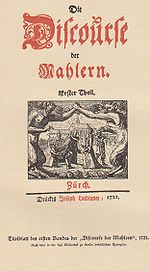Moral weekly
Moral weeklies are a type of magazine that was in circulation in the first half of the 18th century and that dominated the magazine market at that time and contributed significantly to the spread of Enlightenment ideas .
Issues and content
In addition to informing and educating the public, the moral weeklies should also contribute to the formation of opinions and the dissemination of educational values. The editors sought to persuade the public to make rationally justified judgments instead of simply adopting the ideas of traditional authorities. The moral weeklies became an important mouthpiece for educational efforts and increased the readership's moral judgment.
They propagated that it was not only important to be a good Christian, but also to get involved in society. The magazines were designed for a broad and middle-class readership (scholars, theologians, doctors, merchants, scientists, lawyers and so on), as well as for women. In addition to information and education, they should also be used for entertainment.
Morality was understood to mean virtue, ethics, meaning and morality (moral doctrine).
In addition to politics, the topics were the family, education for morality, tolerance, virtue and morality, living together in society and at court and criticism of it. The court and the nobility were mocked, but a new form of government or society was not promoted. Man should act reasonably: virtue and reason had the highest priority, on the other hand irrational superstition was abandoned to contempt.
The moral weeklies were aimed at an educated bourgeois audience . In terms of content, the writings often also dealt with a criticism of the culture and lifestyle of the aristocracy : Typical objects of attack in the mostly satirical criticism were, for example, the conservative schoolmaster, the alien scholar or the arrogant nobleman.
Enlightenment views were presented in a variety of different text forms, including fictitious conversations, letters, fables, songs, and stories. The editors often made use of fictional authors who were given the expressions of opinion and experience reports: for example, in The Sensible Blamers, the middle-class ladies Phyllis, Calliste and Iris chatted as alleged authors in the first person; In Der Biedermann , the alleged author, Ernst Wahrlieb Biedermann, made moral considerations. The titles of the publications were mostly very unusual and original ("The Old Man", "The Defiant Head", "The Scatterer", "The Reasonable Man"). The titles also incorrectly indicated writing individuals.
Some of the readers were encouraged to send in their own articles and letters to the editor . This created a new literary public, in which citizens could express themselves on moral and ideological issues. Fictional letters to the editor were also published to a not inconsiderable extent, in which the alleged readers expressed their enthusiasm for the weeklies, but above all emphasized that the educational content actually only related to general questions of life - but not to current political or religious questions. In addition to self-promotion, the purpose of these restriction formulas is likely to have consisted primarily in preventive protection against censorship measures. Nevertheless, there were actually close reader ties to the respective paper and thus fixed readership groups.
The weeklies were mostly published once a week, some titles also twice a week or only every 14 days. Since - as mentioned - they never dealt with highly topical subjects or events, but rather fundamental political and religious subjects, they could easily be reissued later.
History of origin
The published in Germany moral weeklies arose early 18th century based on models from England , by Joseph Addison , the author, and Richard Steele , published, publisher moral weeklies :
- The Tatler (1708-1711)
- The Spectator (1711-1712, 1714)
- The Guardian (1712-1713)
There was also a forerunner of this new category in France, the “ Mercure Galant ”. Initially, these originals were published as translations and imitations in Germany: here is primarily the early weekly Der Vernunftler . German extract from the Engelländische Moral-Schriften Des Tatler und Spectator , which was edited by Johann Mattheson and published from 1713 to 1714.
In addition to English models, there were also early approaches to critical weekly and monthly publications in Germany that were aimed at a middle-class audience.
This mainly by Christian Thomasius in Leipzig issued Monatsgespräche (published 1688-1690), which successfully passed the German language was established as a media language and where entertaining, one ironically to satirical been maintained linguistic style, in contrast to the prevailing until then scholarly treatises of the Baroque period . Another representative of the new early Enlightenment literary tradition were the Edifying Rest Hours published by Johann Frisch , which had been published weekly in Hamburg since 1676 . They were both instructive and entertaining magazines.
The German moral weeklies can therefore be seen as a synthesis of the English moral weeklies and new tendencies in German-language journalism .
Many German scholars and writers were authors of moral weeklies, including Gotthold Ephraim Lessing and Friedrich Gottlieb Klopstock .
In Germany there were probably over 500 moral weeklies, in England, the country of origin, around 200. However, many of them only existed for a few months or a year. The centers in Germany were Hamburg and Leipzig.
The first women's magazines emerged from the example of the Moralische Wochenschriften, such as “Die vernüßigen Tadlerinnen” (1725–1726), published by Johann Christoph Gottsched , they were published several times later.
Important German-language magazine titles
- Discourse der Mahlern , edited by Johann Jakob Bodmer and Johann Jakob Breitinger in Switzerland (1721 to 1723); Next sheet: Painter of Morals (1746).
- The Patriot (published in Hamburg from 1724 to 1726) marks the breakthrough in moral weeklies in Germany.
- Conversations in the realm of those dead , edited by David Faßmann (1718 to 1739), up to 3,000 copies, reprints even up to 15,000 copies.
- The images of the incidents and people through which the current situation is presented on a monthly basis and it is shown in appropriate headers (published in Augsburg in1725by publisher Augustus Sturm ) is the first magazine with small illustrations .
- The sensible rebukers , published by Johann Christoph Gottsched in Leipzig (1725 to 1727), is aimed at women.
- Der Biedermann , published by Johann Christoph Gottsched in Leipzig (1727 to 1729).
- Der Vernünstler , published by Johann Mattheson in Hamburg (1713–1714), published twice a week.
- Die Matrone , published by Johann Georg Hamann (Hamburg 1728–1730) as one of the first German-language educational magazines
- The philanthropist (Hamburg 1737–1739)
- The Freymäurer (Leipzig 1738)
- The citizen of the world (Berlin 1741–1742)
- The Freydenker (Danzig 1741–1743)
- The Stranger (Copenhagen, Leipzig 1751–1756)
- The sociable (Hall 1745–1746)
- Man (Hall 1751–1756)
- The friend (Ansbach 1754–1756)
- The Nordic Overseer (Copenhagen, Leipzig 1758–1760)
- The Hypochondrist (Schleswig 1762)
- The man without prejudice (Vienna 1765–1767)
See also
literature
- Holger Böning , Michael Nagel, Johannes Weber (eds.): World conquest by a new audience. The German press and the road to education. Hamburg and Altona as an example. Edition Lumière, Bremen 2002.
- Helga Brandes: Moral weeklies. In: Ernst Fischer, Wilhelm Haefs, York-Gothart Mix (eds.): From Almanach to Newspaper. A handbook of the media in Germany 1700–1800. Beck, Munich 1999, ISBN 3406454763 .
- Klaus-Dieter Ertler : Moral weeklies in Spain: 'El Pensador' by José Clavijo y Fajardo. Tübingen: Gunter Narr Verlag, ISBN 3823360191
- Klaus-Dieter Ertler: Moral weeklies , in: European History Online , ed. from the Institute for European History (Mainz) , 2012, accessed on: February 29, 2012.
- Elke Maar: Education through entertainment. The discovery of infotainment in the Enlightenment. Moral weeklies from Halle and Vienna in the heyday of moral journalism 1748–1782. Centaurus, Pfaffenweiler 1995.
- Wolfgang Martens: The Message of Virtue. The enlightenment in the mirror of the German moral weekly papers. Metzler, Stuttgart 1971.
- Ernst Milberg: The German moral weekly papers of the 18th century. Meissen Clinic 1880.
- Rudolf Stöber: German press history. UVK, Konstanz 2005, ISBN 3825227162 .
- Jürgen Wilke : Basics of the history of media and communication. From the beginning to the 20th century. Böhlau, Cologne, Weimar, Vienna 2000.


